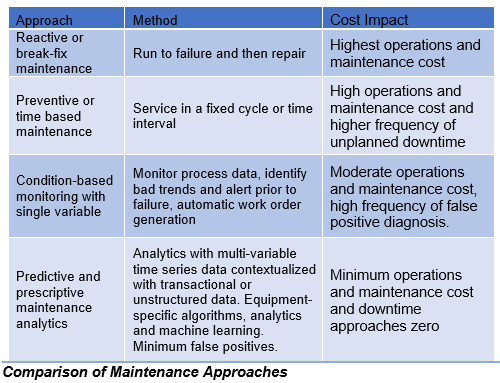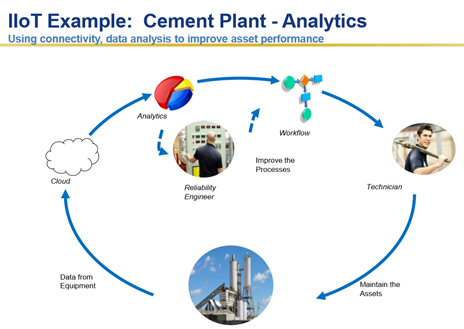Improving Control Valve Maintenance with the Industrial Internet of Things
By connecting previously stranded data from smart sensors, equipment, and other industrial assets with advanced applications and predictive analytics in the cloud, the Industrial Internet of Things (IIoT) is becoming a strategic enabler to improve manufacturing performance.
#maintenance-repair #iiot #automation
One transformational outcome of this union of business and automation technology is reducing maintenance and operations cost by changing the way plant maintenance is executed on certain critical assets. Much like the way Uber has disrupted ride services or Air bnb has disrupted room rentals, industrial companies that fail to adapt to this digitization may also disappear.
IIoT Reshaping Plant Information Architectures
Through IIoT-enabled technologies and strategies, industrial users can collect and store data from almost anything at an extremely high frequency and at incredibly low cost. This enables efficiencies in work and business processes that were not possible in the past.
Distributed control systems (DCS) and programmable logic controllers (PLC) with process historians have been performing some elements of this for decades. While they still deal with sensors and computing, IIoT-enabled solutions can deliver very different outcomes than DCS- and/or PLC-based process automation architectures alone. Historically, process automation systems have been designed for a single purpose; to support process control based on the process design characteristics as spelled out on the process & instrumentation design (P&ID) diagrams. Sensors and actuators (valves, pumps, drives, etc.) that included in a front-end engineering design (FEED) process were almost always expected to be connected to DCS or PLC I/O to support process control, logic, and alert operators via a human machine interface (HMI).
For industrial IoT, both the architecture and expected outcomes are very different. Process automation also follows the Purdue model for computer integrated manufacturing (circa 1980) and the ISA95 model for enterprise-control system integration. The most notable difference between the two architectures is that the ISA95 model focuses on feeding plant data up to the enterprise, while IIoT can extend out to suppliers, customers and partners to enable new business models and processes.
Expertise Gap for Control Valves and Other Critical Assets
In the process industries, one of the most important yet often overlooked assets are the control valves, which are critical for good process control. Without reliable control valve operation, the process would quickly become unmanageable for the process operator.
The average process plant is designed to be heavily automated to provide safe and stable operations with minimal interactions by operators. In general, plant operators have a good understanding of how a process plant operates but many have a knowledge gap when it comes to certain assets. For example, while operators have training for and some basic knowledge of the control valves’ mechanical systems, this does not always extend to the intelligent electronics.
Today’s control valve is a far cry from the easy-to-understand analog valve positioner of the past. Most control valves shipped today include a highly complex digital computer capable of recording a variety of important statuses relating to air supply, electrical supply, travel stroke and parameters related to valve stem or shaft. Exacerbating this situation is the fact that even the plant instrument or electrical teams have rarely received adequate training in this highly complex set of variables and frequently are not afforded the time to learn this technology.
Most Control Valve Maintenance is Expensive and Reactive
Operator effectiveness programs or minor maintenance initiatives address some of the issues to help address reliability, but in the majority of cases control valve maintenance is the responsibility of the plant electrical or instrumentation groups. Larger regional or global industrial organizations have site-resident or global reliability engineers with knowledge of the control valve digital information. However, most owner-operators rely on the OEM equipment manufacturer to interpret the data and assist in the reliability and maintenance of the asset.
Research has shown that the majority of maintenance performed on industrial assets is unnecessary, and certainly costly. Unnecessary reactive and costly break-fix maintenance or preventative maintenance usually constitutes over 80% of the actual work performed by maintenance and operating technicians. Studies also show it is common practice to remove and overhaul many control valves during a turnaround or shutdown. In many cases, no improvement is made to the valve and, in some, cases new faults are introduced inadvertently. The following table illustrates the comparisons between the different maintenance approaches used today.
Emerging IIoT Predictive Analytics for Control Valves
Leading automation suppliers have developed control valve asset management systems to complement their DCS and/or PLC platforms. These systems help maintain reliability and improve access to the information stored in the digital positioner. When used effectively, these systems can provide an accurate prediction of asset health, minimize downtime or help avoid performing unnecessary maintenance.
When coupled with digital positioner technology, modern asset management systems provide a comprehensive valve signature analysis. While critical, this is only a first step in determining the overall health of the valve and related components. Current practice by most industrial companies is to ignore this feature and simply perform scheduled maintenance or fix the control valve when a failure occurs. Predicting failures would require a more substantial look across differing data sets.
Companies that have performed an asset criticality ranking sometimes capture the valve signature for critical valve assets, typically sharing these with the valve OEM supplier and other service providers to assist the analysis via email or USB thumb drives. This approach is not only ad hoc in nature, it can also introduce cybersecurity issues that could threaten the integrity of the process control system.
As an alternative approach, IIoT-enabled remote services and analytics introduce a variety of remote service options. Secure, encrypted data connections using secure socket layer (SSL) over the internet create the opportunity to analyze control valve data and valve signatures as a service.
A new breed of technology supplier has emerged, providing IIoT-enabled process analytics capable of reading and analyzing vast quantities of asset data in near-real-time. Technology suppliers, already skilled at leveraging cloud infrastructure services such as Amazon Web Services or Microsoft Azure, are now accumulating expertise in-house or forming partnerships to develop solutions to fully understand a particular plant asset. By combining data from the control valve asset management solutions (such as the valve signature reports) with process historian data such as flows, pressures and temperatures, industrial process analytics vendors can now provide the needed expertise and efficiency by automating the data aggregation.
The “holy grail” for maintenance has always been to have the most knowledgeable expert(s) perform the service at the right time (and the right price). Owner-operators today perceive the higher value associated with purchasing a control valve from a supplier that can provide remote, IIoT-enabled asset management and predictive services at relatively low cost. For suppliers, being able to securely access and diagnose data from their customers’ installed control valves can help them build a better, more reliable valve and ensure optimum performance.
Based on the high cost of unnecessary maintenance and unplanned downtime, combined with the growing skills gap across industry, ARC expects the use of “Expertise as a Service (EaaS), remote monitoring and diagnostics and other IIoT-enabled services to grow. EaaS paves the way for new workers to join global competency centers or other centers of excellence, thus avoiding the 4 Ds – dull, dirty, dangerous and distant work.
Peter Reynolds is a consultant at ARC Advisory Group, and has more than 20 years of professional experience in process control, advanced automation applications, information technology, and supply chain in the downstream oil refining and petroleum product marketing. Reach him at preynolds@arcweb.com. To learn more about IIoT-enabled strategies and approaches for managing critical production assets, readers are invited to visit ARC’s blog: Internet of Things.
RELATED CONTENT
-
Grease for Motor Actuator Maintenance
Maintaining the right amount of grease inside motor actuators that use grease for lubrication is a vital part of valve maintenance, and can save time and money by preventing problems before they happen.
-
Caution: Horizontal Stem Installation Ahead
When it comes to linear valve installations, gravity is our friend.
-
The Nuts and Bolts of Nuts and Bolts
Repairing a valve usually means discarding old fasteners and replacing them with new ones.












 Unloading large gate valve.jpg;maxWidth=214)